See also
- Lomas de Chapultepec, a colonia near Chapultepec
- Chapultepec aqueduct, an aqueduct in Chapultepec
- Chapultepec Peace Accords, a 1992 Salvadorian peace treaty
Chapultepec is a city park in Mexico City.
Chapultepec may also refer to:

Mexico City is the capital and largest city of Mexico and the most populous city in North America. Mexico City is one of the most important cultural and financial centers in the world. It is located in the Valley of Mexico, a large valley in the high plateaus in the center of Mexico, at an altitude of 2,240 meters (7,350 ft). The city has 16 subdivisions known as boroughs or demarcaciones territoriales.

Chapultepec, more commonly called the "Bosque de Chapultepec" in Mexico City, is one of the largest city parks in the Western Hemisphere, measuring in total just over 686 hectares. Centered on a rock formation called Chapultepec Hill, one of the park's main functions is as an ecological space in Greater Mexico City. It is considered the first and most important of Mexico City's "lungs", with trees that replenish oxygen to the Valley of Mexico. The park area has been inhabited and considered a landmark since the Pre-Columbian era, when it became a retreat for Aztec rulers. In the colonial period, Chapultepec Castle was built here, eventually becoming the official residence of Mexican heads of state. It would remain so until 1940, when it was moved to another part of the park called Los Pinos.
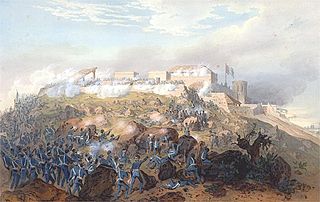
The Battle of Chapultepec was an assault by invading American forces on a small contingent of Mexican forces holding the strategically located Chapultepec Castle just outside Mexico City, fought 13 September 1847 during the Mexican–American War. The building, sitting atop a 200-foot (61 m) hill, was an important position for the defense of the city.

Miguel Hidalgo is one of the 16 alcaldías (municipalities) into which Mexico City is divided. It was created in 1970 when central Mexico City was divided into four boroughs. Miguel Hidalgo joined the historic areas of Tacuba, Chapultepec and Tacubaya along with a number of notable neighborhoods such as Polanco and Lomas de Chapultepec. With landmarks such as Chapultepec Park and the Museo Nacional de Antropología, it is the second most visited borough in Mexico City after Cuauhtémoc, D.F. where the historic center of Mexico City is located. Tacubaya and Tacuba both have long histories as independent settlements and were designated as “Barrios Mágicos” by the city for tourism purposes.

Sevilla is a station on Line 1 the Mexico City Metro. It is located in the Cuauhtémoc borough in the centre of Mexico City, on Avenida Chapultepec and Sevilla street. It serves colonias Roma and Juárez.

Balderas is an underground station on the Mexico City Metro. It is located in the Cuauhtémoc borough in the center of Mexico City. It is a transfer station along Lines 1 and 3.

Juanacatlán is a metro station on the Mexico City Metro. It is located in Mexico City's Miguel Hidalgo municipality in the San Miguel Chapultepec neighborhood, and lies on Line 1 of the Metro. In 2019 the station had an average ridership of 11,669 passengers per day, making it the least used station in Line 1.
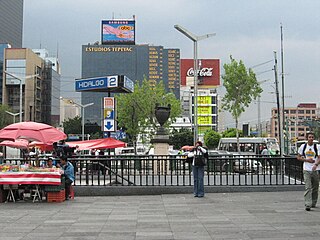
Hidalgo is a station on Line 2 and Line 3 of the Mexico City Metro system. It is located in the Cuauhtémoc borough of Mexico City, west of the city center, on Hidalgo Avenue and serves the Colonia Tabacalera, Colonia Guerrero, and Colonia Centro districts.
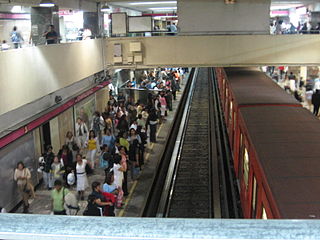
Chapultepec is a station on the Mexico City Metro. It is located in the Cuauhtémoc borough in the centre of Mexico City. In 2019, the station had an average ridership of 57,873 passengers per day, making it the 14th busiest station in the network.
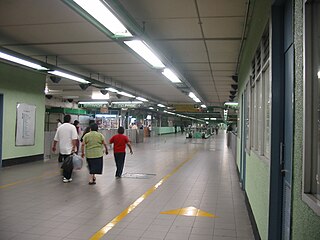
Salto del Agua is a metro (subway) station on the Mexico City Metro. It is located in the Cuauhtémoc borough in the centre of Mexico City.

The Niños Héroes were six Mexican military cadets who were killed in the defence of Mexico City during the Battle of Chapultepec, one of the last major battles of the Mexican–American War, on 13 September 1847. The date of the battle is now celebrated in Mexico as a civic holiday to honor the cadets' sacrifice.

Chapultepec Castle is located on top of Chapultepec Hill in Mexico City's Chapultepec park. The name Chapultepec is the Nahuatl word chapoltepēc which means "hill of the grasshopper". The castle has such unparalleled views and terraces that explorer James F. Elton wrote they “can't be surpassed in beauty in any part of the world." It is located at the entrance to Chapultepec Park at a height of 2,325 meters above sea level. The site of the hill was a sacred place for Aztecs, and the buildings atop it have served several purposes during its history, including that of Military Academy, Imperial residence, Presidential residence, observatory, and since the 1940s, the National Museum of History. Chapultepec Castle, along with Iturbide Palace, also in Mexico City, are the only royal palaces in North America.

Chapultepec Zoo is a zoo located in Chapultepec Park; it is one of four zoos near Mexico City, and the best known Mexican zoo. It was founded July 6, 1923 by Mexican biologist Alfonso Luis Herrera using donations from private citizens and governmental funds from the Ministry of Agriculture and Development, and also with funds from the Society of Biological Studies.

Auditorio is a Mexico City Metro station located on line 7. It is one of the main metro gateways to the chic and business-related neighbourhood, Polanco. The entrances to the station are on Paseo de la Reforma, one of the main thoroughfares in Mexico City.
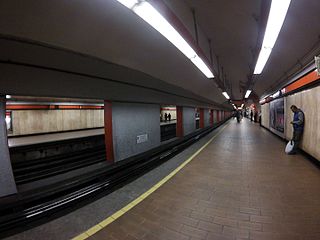
Constituyentes is a station on Line 7 of the Mexico City metro on the western outskirts of the city center. It serves Chapultepec Park and numerous attractions therein, as well as the Luis Barragán House and Studio. The station opened on 23 August 1985.

Mexico City Metro Line 1 is one of the twelve metro lines operating in Mexico City, Mexico. Officially inaugurated in 1969, it went to become the first metro line to be built in the country. Its identifying color is pink and it runs through the city from west to east.

La Feria de Chapultepec, simply branded as La Feria, was an amusement park in Mexico City, Mexico. Located in the middle of Chapultepec Park near the Constituyentes Metro station, it opened in 1964 as Juegos Mecánicos de Chapultepec and was originally operated by the Mexican government. In 1992 Grupo CIE bought it and changed the name to La Feria Chapultepec Mágico. In 2015, it was bought by Ventura Entertainment and renamed to its last name.

The Chapultepec aqueduct was built to provide potable water to Tenochtitlan, now known as Mexico City. This fresh water was transported from the Chapultepec springs. Two aqueducts following the same route from the springs were built by the Aztecs during the 15th century, the first destroyed by flooding and the second by the Spanish. After the Spanish conquest a colonial aqueduct was built, the ruins of which are located near Metro Sevilla.

Mexico City Metro Line 7 is one of the twelve metro lines operating in Mexico City, Mexico.

The Baths of Chapultepec as a series of deposits used from the pre-Columbian period until the beginning of the 20th century, to houses the waters of the springs of the hill of Chapultepec that served to provide drinking water to Mexico City. Among the remains of these are the so-called Baths of Moctezuma in Chapultepec which was recently remodeled, and the remains of some colonial baths in the Well 5 or Manantial Chico of Chapultepec.